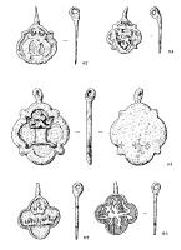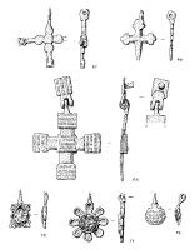Overview of Bards
Western European Trappings from 900-1600 c.e.
By Madonna Contessa Ilaria Veltri degli Ansari
This page is very long, please give it time to load
Open Type
Closed Type
Saddle Cloth Type
Combinations of Styles
No Bards at All
Something Completely Different!
Metal Tack Ornaments
Bibliography
Bards
Period horse coverings can be called by many names. Bards, Housings, Trappings or Caparisons.
My Webster's New Collegiate Dictionary gives these definitions:
Bard:
1. A piece of armor or ornament for a horse's neck, breast or flank.
2. To furnish with bards.
Caparison:
1. a. An ornamental covering for a horse.
b.Decorative trappings and harness.
2. Rich clothing: adornment.
Housing:
1. An ornamental cover for a saddle.
2. Trapping.
Trap, trapped, trapping:
To adorn with or as if with trappings.
Trapping:
1: Caparison
2: Outward decoration or dress: ornamental equipment.
I leave it to you to choose the one you like.
I have divided bards into three basic categories, open, full coverage and extended blanket. Up until the about 1100 Bards as we think of them weren't really used. They would decorate their tack, sometimes quite elaborately, but full coverage bards hadn't been invented yet, and "open" style was really functional. I have included some pictures of Greeks, Romans and others to give an indication of what they did.
Open Type
Open generally, is a decorated or decorative breeching and breast collar, with or without decorated bridles and reins. Exactly where decoration ends and functionality begins is an open question. All of the decorative open bards may have been functional, or only some may have been.
a. Frankish calvary of the Carolingian Empire, from the Golden Psalter
b. Saint George and the Dragon by Freidrich Herlin, c.1460
c. Froissart's Chronicles
d. King Rene's Book of Tournament
e. Journey of the Maji
Full Coverage Type
Full coverage may cover the head and neck or not, but usually covers the rump and flanks and the shoulders of the horse. Sometimes the front parts cover the legs of the rider as well.
f. Probably the most famous bards. Luttrell Psalter, c 1340. Geoffrey Luttrel armed for war with his wife and daughter.
Note arms on front and back bards, chanfron and saddle. Note linings are contrasting color.
g. Miniature from an Address by the town of Prato to Robert of Anjou, Italy, c.1335-1340, British Museum
h. A joust, showing a course of the Gestech, German
i. Ulrich Von Lichtenstein c.1300 Codex Manesse, Heidelberg.
j. Crested German Knight Walther von Klingen, shattering a lance, unseats his opponent. c.1300
Codex Manesse, Heidelberg.
k. The Dukes of Brittany and Bourbon, a detail from King Rene's Book of the Tournament by Louis d'Aryon, 14th c
Blanket Type
An extended saddle blanket may either be a slightly large blanket with a fancy edging or a wide strip of cloth across the back of the horse, which can extend as far as the ground. Extended saddle blankets are often combined with open bards of various types.
k. Commodus Hunting, Museo Nazionale, Naples
l. Detail of a knight, possibly Robert, Earl of Glouster (d.1147),
from the History of the Kings of Britian by Geoffrey of Monmouth c.1136
m. Detail from the Minnesanger Manuscript
n. Detail from Tres Riches Heures of the Duc de Berry
o. Saddle cloth detail from The Journey of the Maji, by Gentile da Fabriano, Uffizi Gallery, Florence
Combinations
Of course, the various kinds of bards could be used by different people at the same "event" or by the same person at different types of events. It is common to see Knights jousting with full coverage bards on their horses and the various "helpers" with open or no bards at all. Folk rarely used full coverage bards when hunting.
p. A late 15th c. manuscript illumination of the tournament at St Inglevert in 1390, as described in Froissart's Chronicles,
q. A 15th century Flemish Joust
r. A Joust in 1500 Munich
s. A Joust in 1561 Nuremberg
No bards at all
Of course, there are plenty of pictures out there where the horse is wearing no bards or other decorative trappings of any kind.
t. Detail from the Bayeaux Tapestry
u. Detail of a 15th c painting depicting a war scene.
Something completely different
Paint
v. A Polish Winged Hussar detail, from the Wedding Procession of Constance of Austria and Sigimund III into Cracow. The Stockholm Roll after 1605
Metal Ornaments
Metal ornaments were frequently used on tack through the Middle Ages. They took two general forms: round or rectangular studs, now known as "spots" in draft horse circles, and pendants. Some examples of pendants are shown here.


w. 12thc. silver plaque in the Abbaye de St. Maurice, Valais, Switzerland
x. Sketches of decorative tack pendants found in London. Museum of London
BIBLIOGRAPHY
The Age of Chivalry
A volume in the story of man library
Ed. Kenneth M. Setton
National Geographic Society 1969
Bit by Bit
Dianna R. Tuke
J.A.Allen and Co. Ltd.
London, 1991
Bits
Louis Taylor
Wilshire Book Co.
N. Hollywood, CA 1966
Bits and Bitting Manual
William G. Langdon, Jr.
Langdon Enterprises
Colbert, WA 1989
Arms and Armour of the Medieval Knight
David Edge and John Miles Paddock
Crescent Books
New York, 1988
Art in Poland 1572-1764
Land of the Winged Hussars
Art Services International
Alexandria, VA 1999
Cavalry
The history of mounted warfare
John Ellis
G.P.Putnam's Sons
New York, 1978
Discovering Harness and Saddlery
G.Tylden, Major
Shire Publications, Ltd.
Aylesbury, Bucks, UK 1979
A History of Horsemanship
Charles Chenevix-Tench
Doubleday & Co., Inc.
Garden City, NY 1970
EQUUS
The Horse in the Roman World
Ann Hyland
Yale University Press,
New Haven and London, 1990
A History of Horsemanship
Charles Chenevix-Trench
Doubleday and Co. Inc.
Garden City, NY, 1970
The Horse in Medieval England
Herbert James Hewitt
J.A.Allen and Co. Ltd.
London, 1983
Horse Power
Juliet Clutton-Brock
Harvard University Press
Cambridge, MA, 1992
Horse Tack
The complete equipment guide
for riding and driving
Ed. Julie Richardson
William Morrow and Co. Inc., London 1981
Horses and Horsemanship Through the Ages
Luigi Gianoli
Crown Publishers
1969
The Howell Book of Saddlery and Tack
Ed. Elwyn Hartley-Edwards
Howell Book House Inc.
New York, 1981
The Life, History and Magic of the Horse.
Donald Braider
Madison Square Press
Grosset & Dunlap, Publishers
New York, 1973
Know All About Tack
George Dulaney
The Farnam Horse Library
Omaha, NB, 1974
Making and Repairing Western Saddles
Dave Jones
Arco Publishing, Inc.
New York, 1982
Man and Horse in History
Matthew J. Kust
Plutarch Press
Alexandria, VA 1983
Man and the Horse,
A. Mackay-Smith, J.R. Druesedow
T. Ryder
Simon and Schuster, New York, 1984
The Medieval Horse and its Equipment
c. 1150-c.1450
ed. John Clark
Museum of London, London, 1995
Medieval Pageant
Bryan Holme
Thames and Hudson
London, 1987
The Medieval Warhorse
R.H.C.Davis
Thames and Husdson
London, 1989
The Noble Horse
Werner Schmalenbach
J.A.Allen and Co.
London, 1962
The Noble Horse
Monique and Hans D. Dossenbach
Crescent Books
New York, 1994
The Pictorial Arts of the West 800-1200
C.R. Dodwell
Yale University Press
New Haven & London, 1993
Princely Feasts and Festivals
Bryan Holme
Thames and Hudson
London, 1988
The Reign of Chivalry
Richard Barber
St. Martin's Press
New York 1980
The Rider's Handbook
A step-by-step course
Sally Gordon
Chartwell Books, Inc.
Secaucus, New Jersey 1979
The Roman Cavalry
Karen R. Dixon and Pat Southern
Barnes and Noble Books
New York, 1992
The Royal Horse of Europe
Sylvia Loch
J.A. Allen & Co. Ltd., London, 1986
Saddles
Russel H. Beatie
University of Oklahoma Press
Norman & London, 1981
Saddlery
E.Hartley Edwards
J.A.Allen and Co. Ltd.
London, 1987
They Rode Into Europe
Miklos Jankovich
Charles Srcribner's Sons
New York 1971
To Handmake a Saddle
J.H.L.Shields
J.A.Allen and Co.
London, 1983
| My page on making bards |
| 15th Century Caparisons by Baroness AElfrida Grusmach |
| Home |
| Email me |
| Top of Page |